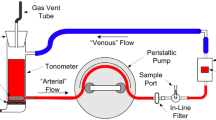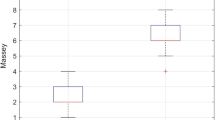Abstract
One of the most significant limitations of oximeters is their performance under poor perfusion conditions. This systematic review examines pulse oximeter model accuracy in adults under poor perfusion conditions. A multiple database search was conducted from inception to December 2020. The inclusion criteria were as follows: (1) adult participants (> 18 years) with explicitly stated conditions that cause poor peripheral perfusion (conditions localized at the oximeter placement site; or systemic conditions, including critical conditions such as hypothermia, hypotension, hypovolemia, and vasoconstricting agents use; or experimental conditions) (2) a comparison of arterial oxygen saturation and arterial blood gas values. A total of 22 studies were included and assessed for reliability and agreement using a modified Guidelines for Reporting Reliability and Agreement Studies tool. We calculated the accuracy root mean square error from bias and precision we extracted from the studies. Most oximeters (75%) were deemed accurate in patients with poor perfusion. Modern oximeters utilizing more complex algorithms were more likely to be accurate than older models. Earlobe placement of oximeters seemed more sensitive, with greater measurement accuracy, than on fingertip placement. Only one study controlled for skin pigmentation, and none strictly followed Food and Drug Association recommendations for experiments to determine oximeter accuracy. Oximeters are accurate in poorly perfused patients, especially newer oximeter models and those placed on earlobes. Further studies are needed that examine multiple oximeter models used on a diverse selection of patients while following FDA recommendations to examine oximeter accuracy.

Similar content being viewed by others
Data availability
Not applicable.
Code availability
Not applicable.
Abbreviations
- ABG:
-
Arterial Blood Gas
- SpO2 :
-
Oxyhemoglobin Saturation
- FDA:
-
Food and Drug Administration
- ED:
-
Emergency Department
- ICU:
-
Intensive Care Unit
- Arms :
-
Accuracy Root Mean Square
References
Cannesson M, Talke P. Recent advances in pulse oximetry. F1000 Med Rep. 2009. https://doi.org/10.3410/M1-66.
Chan ED, Chan MM, Chan MM. Pulse oximetry: understanding its basic principles facilitates appreciation of its limitations. Respir Med. 2013;107(6):789–99.
LaPier J, Chatellier M. Optimizing portable pulse oximeter measurement accuracy and consistency during exercise. Journal of Acute Care Physical Therapy. 2017;8(3):96–105.
Carter R, Williams JS. Oximetry update: applications, limitations, and new technologies: new oximetry technology has reduced the problems of motion artifact and low perfusion. RT for Decision Makers in Respiratory Care. 2008;21(3):20–3.
Louie A, Feiner JR, Bickler PE, Rhodes L, Bernstein M, Lucero J. Four types of pulse oximeters accurately detect hypoxia during low perfusion and motion. Anesthesiology. 2018;128(3):520–30.
Administration FD: pulse oximeter accuracy and limitations: FDA safety communication. https://www.fda.gov/medical-devices/safety-communications/pulse-oximeter-accuracy-and-limitations-fda-safety-communication (2021).
Nasr VG, DiNardo JA. Pulse oximetry. Pediatr Rev. 2019;40(11):605–8.
Louw A, Cracco C, Cerf C, Harf A, Duvaldestin P, Lemaire F, et al. Accuracy of pulse oximetry in the intensive care unit. Intensive Care Med. 2001;27(10):1606–13.
Kottner J, Audigé L, Brorson S, Donner A, Gajewski BJ, Hróbjartsson A, et al. Guidelines for reporting reliability and agreement studies (GRRAS) were proposed. Int J Nurs Stud. 2011;48(6):661–71.
Harford M, Catherall J, Gerry S, Young JD, Watkinson P. Availability and performance of image-based, non-contact methods of monitoring heart rate, blood pressure, respiratory rate, and oxygen saturation: a systematic review. Physiol Meas. 2019;40(6):06.
Bland JM, Altman DG. Agreement between methods of measurement with multiple observations per individual. J Biopharm Stat. 2007;17(4):571–82.
Medical electrical equipment—Part 2–61: Particular requirements for basic safety and essential performance of pulse oximeter equipment. Medical electrical equipment—Part 2–61: Particular requirements for basic safety and essential performance of pulse oximeter equipment: ISO; 2017. p. 90.
Buist R, Gabrielczyk M. Pulse oximetry and postoperative hypothermia. Anaesthesia. 1988;43:402–4.
Kurki TS, Smith NT, Sanford TJ, Head N. Pulse oximetry and finger blood pressure measurement during open-heart surgery. J Clin Monit. 1989;5(4):221–8.
Falconer R, Robinson B. Comparison of pulse oximeters: accuracy at low arterial pressure in volunteers. BJA British J Anaesth. 1990;65(4):552–7.
Clayton D, Webb R, Ralston A, Duthie D, Runciman W. Pulse oximeter probes A comparison between finger, nose, ear and forehead probes under conditions of poor perfusion. Anaesthesia. 1991;46(4):260–5.
Clayton D, Webb R, Ralston A, Duthie D, Runciman W. A comparison of the performance of 20 pulse oximeters under conditions of poor perfusion. Anaesthesia. 1991;46(1):3–10.
Pälve H, Vuori A. Accuracy of three pulse oximeters at low cardiac index and peripheral temperature. Crit Care Med. 1991;19(4):560–2.
Pälve H, Vuori A. Minimum pulse pressure and peripheral temperature needed for pulse oximetry during cardiac surgery with cardiopulmonary bypass. J Cardiothorac Vasc Anesth. 1991;5(4):327–30.
Stewart K, Rowbottom S. Inaccuracy of pulse oximetry in patients with severe tricuspid regurgitation. Anaesthesia. 1991;46(8):668–70.
Withington DE, Ramsay JG, Saoud AT, Bilodeau J. Weaning from ventilation after cardiopulmonary bypass: evaluation of a non-invasive technique. Can J Anaesth. 1991;38(1):15–9.
Pälve H. Reflection and transmission pulse oximetry during compromised peripheral perfusion. J Clin Monit. 1992;8(1):12–5.
Trivedi NS, Ghouri AF, Shah NK, Lai E, Barker SJ. Effects of motion, ambient light, and hypoperfusion on pulse oximeter function. J Clin Anesth. 1997;9(3):179–83.
Durbin CG Jr, Rostow SK. More reliable oximetry reduces the frequency of arterial blood gas analyses and hastens oxygen weaning after cardiac surgery: a prospective, randomized trial of the clinical impact of a new technology. Crit Care Med. 2002;30(8):1735–40.
Hinkelbein J. Comparison of three different sensor sites for pulse oximetry in critically ill patients. International Journal of Intensive Care. 2005;12(4):159.
MacLeod D, Cortinez L, Keifer J, Cameron D, Wright D, White W, et al. The desaturation response time of finger pulse oximeters during mild hypothermia. Anaesthesia. 2005;60(1):65–71.
Rakhee R. Masimo-a new reliable non invasive method of detecting oxygen saturation in critically ill. Indian J Anaesth. 2005;49(2):133.
Levrat Q, Petitpas F, Bouche G, Debaene B, Mimoz O. Usefulness of pulse oximetry using the SET technology in critically ill adult patients. Annales francaises d’anesthesie et de reanimation. Amsterdam: Elsevier; 2009. p. 640–4.
Wilson BJ, Cowan HJ, Lord JA, Zuege DJ, Zygun DA. The accuracy of pulse oximetry in emergency department patients with severe sepsis and septic shock: a retrospective cohort study. BMC Emerg Med. 2010;10(1):1–6.
Nesseler N, Frénel J-V, Launey Y, Morcet J, Mallédant Y, Seguin P. Pulse oximetry and high-dose vasopressors: a comparison between forehead reflectance and finger transmission sensors. Intensive Care Med. 2012;38(10):1718–22.
Ebmeier S, Barker M, Bacon M, Beasley R, Bellomo R, Chong CK, et al. A two centre observational study of simultaneous pulse oximetry and arterial oxygen saturation recordings in intensive care unit patients. Anaesth Intensive Care. 2018;46(3):297–303.
Seifi S, Khatony A, Moradi G, Abdi A, Najafi F. Accuracy of pulse oximetry in detection of oxygen saturation in patients admitted to the intensive care unit of heart surgery: comparison of finger, toe, forehead and earlobe probes. BMC Nurs. 2018;17(1):1–7.
Goldman JM, Petterson MT, Kopotic RJ, Barker SJ. Masimo signal extraction pulse oximetry. J Clin Monit Comput. 2000;16(7):475–83. https://doi.org/10.1023/A:1011493521730.
Administration USFD: 510(k) Premarket notification. https://www.accessdata.fda.gov/scripts/cdrh/cfdocs/cfpmn/pmn.cfm?ID=K061052. Accessed 26 May 2006.
Systems GM. Tram-rac 4A HousingService Manual (Two Board). GE Medical Systems; 2001.
Lee YL, Goh MH, Ong YY. Discrepancy in finger pulse oximetry reading related to positioning: a case report. Proc Singapore Healthc. 2020;29(2):104–7.
Gehring H, Hornberger C, Matz H, Konecny E, Schmucker P. The effects of motion artifact and low perfusion on the performance of a new generation of pulse oximeters in volunteers undergoing hypoxemia. Respir Care. 2002;47(1):48–60.
Jensen LA, Onyskiw JE, Prasad N. Meta-analysis of arterial oxygen saturation monitoring by pulse oximetry in adults. Heart Lung. 1998;27(6):387–408.
Mechem CC. Pulse oximetry. In: Parsons PE, editor. UpToDate. Waltham, MA Accessed 25 June 2021.
Perkins GD, McAuley DF, Giles S, Routledge H, Gao F. Do changes in pulse oximeter oxygen saturation predict equivalent changes in arterial oxygen saturation? Crit Care. 2003;7(4):R67. https://doi.org/10.1186/cc2339.
Talke P, Stapelfeldt C. Effect of peripheral vasoconstriction on pulse oximetry. J Clin Monit Comput. 2006;20(5):305–9.
Sjoding MW, Dickson RP, Iwashyna TJ, Gay SE, Valley TS. Racial Bias in Pulse Oximetry Measurement. N Engl J Med. 2020;383(25):2477–8. https://doi.org/10.1056/NEJMc2029240.
Eberhard P, Gisiger P, Gardaz J, Spahn D. Combining transcutaneous blood gas measurement and pulse oximetry. Anesth Analg. 2002;94(1 Suppl):S76-80.
Lindholm P, BloGG SL, Gennser M. Pulse oximetry to detect hypoxemia during apnea: comparison of finger and ear probes. Aviat Space Environ Med. 2007;78(8):770–3.
Jubran A. Pulse oximetry. Crit Care. 2015;19(1):272. https://doi.org/10.1186/s13054-015-0984-8.
Funding
Funding was provided by the ResMed Research Chair of Anesthesia, Sleep, and Perioperative Medicine Fund at University Health Network.
Author information
Authors and Affiliations
Contributions
KP, CP, JA: These authors designed the study, collected, analyzed, and interpreted the data; and prepared the manuscript. KL: This author prepared the manuscript. MP: This author prepared the manuscript. ME: This author designed and executed database search strategies and prepared the manuscript. FC: This author designed the study, interpreted the data, and prepared the manuscript. MN: This author designed the study, analyzed and interpreted the data, and prepared the manuscript.
Corresponding author
Ethics declarations
Conflict of interest
Frances Chung: Reports research support from the University Health Network Foundation. Royalties from Up-To-Date. Consultant to Takeda Pharma. The STOP-Bang proprietary to University Health Network. All other authors have no conflicts to disclose.
Ethical approval
Not applicable.
Consent to participate
Not applicable.
Consent for publication
Not applicable.
Additional information
Publisher's Note
Springer Nature remains neutral with regard to jurisdictional claims in published maps and institutional affiliations.
Khashayar Poorzargar and Chi Pham share first authorship. Frances Chung and Mahesh Nagappa shared senior authorship.
Supplementary Information
Below is the link to the electronic supplementary material.
Rights and permissions
About this article
Cite this article
Poorzargar, K., Pham, C., Ariaratnam, J. et al. Accuracy of pulse oximeters in measuring oxygen saturation in patients with poor peripheral perfusion: a systematic review. J Clin Monit Comput 36, 961–973 (2022). https://doi.org/10.1007/s10877-021-00797-8
Received:
Accepted:
Published:
Issue Date:
DOI: https://doi.org/10.1007/s10877-021-00797-8




